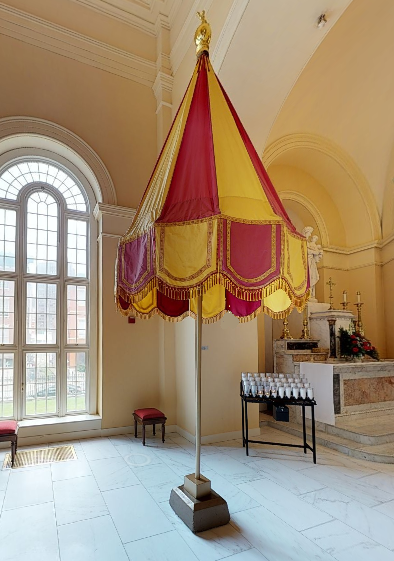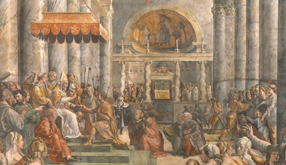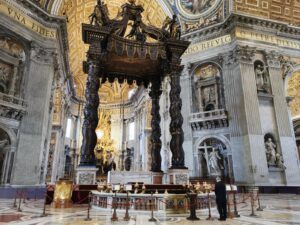
Gian Lorenzo Bernini’s baldacchino or baldachin is one of the most noticeable features in the interior of St. Peter’s Basilica in Rome. The massive bronze structure was built to signify the importance of the main altar and the tomb of St. Peter, which is directly under the main altar.
If you travel around Rome, you will notice that all of the major churches in the city, as well as numerous cathedrals around the world, have a similar structure, called a ciborium, over the main altar.
“Ciborium” however is more commonly used today as the name of the sacred vessel that contains the hosts before and after consecration. What is the connection between the architectural feature and the sacred vessel and why is St. Peter’s ciborium called a baldacchino?
The canopy-like structure over the high altar conveys a sense of reverence for the object it covers. It has roots in the cloth canopies used in ancient history by the pharaohs of Egypt and the kings of the Near East, and the tradition was continued by European monarchs. Stationary cloth coverings, a canopy of state, were incorporated into European palaces as permanent coverings over a throne or royal bed. The cloth used for these structures was called baldachin, and over time, the word for the cloth, originally a fine silk from Baghdad, began to denote the entire canopy structure.
The mobile cloth canopy was incorporated in Catholic liturgies, and today, a processional canopy is used during eucharistic processions. The pope, similar to European monarchs, was provided a canopy. The papal canopy, umbraculum, has one pole, and looks similar to an umbrella. Every basilica in the world has a closed umbraculum to the right of the main altar, which is only opened when the pope is present, and it represents the authority of the pope.
If you look closely at Bernini’s work in St. Peter’s, you will notice that he imitated a cloth canopy using bronze, and thus, it is called a baldacchino, though a ciborium. A ciborium, unlike a baldachin, is a permanent canopy over an altar supported by columns, but that they have a similar purpose as a reverential covering is clearly evident.

In the middle of the 20th century, archeologists found the “Trophy of Gaius” a shrine over the tomb of St. Peter, which was constructed in the second century, making it one of the oldest Christian structures in existence. It is in the form of an aedicula, which translates from Latin as “little temple.” The standard form was “composed of four columns and some kind of gabled roof resembling an architrave and pediment. Basically, if we break a Roman temple down to its simplest form, it becomes two columns supporting a beam and a triangle.” The trophy over the tomb of St. Peter has two columns supporting a flat roof with the back of the roof attached a red wall and then another set of two columns supporting a architrave (beam) and pediment (triangle).
When Christianity was legalized in the fourth century by Constantine, he ordered that basilicas be built over holy sites. When these churches were built, ciboria were placed over the altars using the tradition of the aedicula and baldachin. Early examples survive in Italy and the Holy Land.
These early ciboria had rods built into the columns which held curtains and the curtains would be closed during the most sacred part of the liturgy. This cloth represents the veil on the tabernacle of the Holy of Holies, the earthly dwelling place of Yahweh, built by the ancient Israelites.
With the legalization of Christianity, it was possible to publicly store consecrated hosts without the constant fear of desecration. In some cases, the consecrated hosts stored in a container that was suspended from a chain attached to the center of the canopy above the altar. The ciborium thus served as an early form of a tabernacle for storing the Blessed Sacrament, and this again reinforces the connection of the ciborium to the ancient Holy of Holies. Ciborium is even today used in Italian for the tabernacle. The relationship between the architectural ciborium and the sacred vessel should now be evident

The etymology of the word “ciborium” is not clear but possibly has roots in the Greek word kirorion, which translates as cup or the Latin word for food, cibus. “Ciborium” was used in the medieval period to refer chiefly to the architectural feature, but in the modern period, it refers almost exclusively to the vessel, implying that the word was originally used for the canopy, then a container hanging from the canopy, and finally, the vessel itself. The declining use of the word ciborium as an architectural structure corresponds to a decline in its use. In northern Europe, the rood screen became more popular, and in the East, it was replaced by the iconostasis.
Old St. Peter’s, built by Constantine, interestingly, had both a screen and a ciborium. The screen had the famous curved and twisted Solomonic columns, which were donated by Constantine and claimed to come from the Temple of Solomon (unlikely considering the temple was destroyed 900 years before Constantine). Some of these ancient columns were incorporated in New St. Peter’s, notably as decorative items in the massive columns supporting the new dome. Bernini designed the curved columns of his baldacchino with these ancient Solomonic columns in mind.
I learned that Bernini’s baldacchino was actually a ciborium a few days ago, and the search to find out why lead me to discover so many incredible Catholic traditions. That is the richness and beauty of the Catholic culture.
Copyright © 2020 Catholic Review Media

